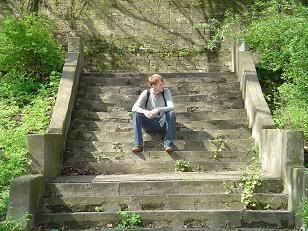Just putting up a few pictures to try to illustrate why I'm enjoying my time here in Vilnius, both inside the archives and out. I'm here hoping to uncover more about the ways that local Communist Party and other officials dodged, altered, or ignored policy directives from Moscow. There's nothing obvious, and I don't expect there to be, but it's interesting material anyway, and the days in the archives go fast (which is, in my opinion, a good thing).
I'm continuing my tradition of taking in the city, bit by bit. This is a square near the guest house in which I am staying. I pass it on my way to and from the archive, and the city's oldest sections as well.
I'm continuing my tradition of taking in the city, bit by bit. This is a square near the guest house in which I am staying. I pass it on my way to and from the archive, and the city's oldest sections as well.
Today, it turns out that some people gathered together in the square, as best as I can tell, to blow bubbles. What's not to love about this place?
I also pass this guy daily, he sits in front of a store selling glasses, truly man's best friend.
Who doesn't love hot air balloons?
So the last time I posted pictures, they were mainly from the area along Gedimino pr., the main street in the part of the city that is mostly from the later 19th century. A day or two after I took those pictures, I wandered into the old part of the city, where many of the buildings are from the 16th-18th c.c., including an innumerable number of Baroque churches. One of the first things I found was the university. I'm guessing I don't have to translate the above.
And here is the courtyard of the university, one of the first in Eastern Europe and long a center of learning and alma mater of many famous writers, including Czesław Miłosz and Adam Mickiewicz.
You will not be surprised to learn that I've been trying out the coffee houses, many of which offer excellent opportunities for sitting on the sidewalk and enjoying the fresh air and free WiFi.
This is one of the attractions of the old city, the entrance at the top of one of the long, winding streets that leads down to a square (pictured below).
Through the above arch, you can see the narrow street (and this is one of the main, wide ones!) and one of the modest number of gaggles of tourists, most of which seem to be from Lithuania itself or neighboring countries.
This is the other side of the gate, where you can see that there is a chapel above, which gives the Gate of Dawn a little something special, in addition to its well proportioned structure.
Another example of the aforementioned Baroque.
And the square, where there are a number of stores, restaurants, cafes, people on segues, and riding a contraption, the name of which - "velo-baras" - requires no translation beyond the reminder that masculine nouns in Lithuanian mostly end in an "-as" suffix.
I also pass this guy daily, he sits in front of a store selling glasses, truly man's best friend.
Who doesn't love hot air balloons?
So the last time I posted pictures, they were mainly from the area along Gedimino pr., the main street in the part of the city that is mostly from the later 19th century. A day or two after I took those pictures, I wandered into the old part of the city, where many of the buildings are from the 16th-18th c.c., including an innumerable number of Baroque churches. One of the first things I found was the university. I'm guessing I don't have to translate the above.
And here is the courtyard of the university, one of the first in Eastern Europe and long a center of learning and alma mater of many famous writers, including Czesław Miłosz and Adam Mickiewicz.
You will not be surprised to learn that I've been trying out the coffee houses, many of which offer excellent opportunities for sitting on the sidewalk and enjoying the fresh air and free WiFi.
This is one of the attractions of the old city, the entrance at the top of one of the long, winding streets that leads down to a square (pictured below).
Through the above arch, you can see the narrow street (and this is one of the main, wide ones!) and one of the modest number of gaggles of tourists, most of which seem to be from Lithuania itself or neighboring countries.
This is the other side of the gate, where you can see that there is a chapel above, which gives the Gate of Dawn a little something special, in addition to its well proportioned structure.
Another example of the aforementioned Baroque.
And the square, where there are a number of stores, restaurants, cafes, people on segues, and riding a contraption, the name of which - "velo-baras" - requires no translation beyond the reminder that masculine nouns in Lithuanian mostly end in an "-as" suffix.













2 comments:
Fun facts with Kathleen: the painting of Mary in Ostra Brama is the most important in Polish Catholicism after the Black Madonna of Częstochowa.
I did not know that, I guess you do learn something every day!
Post a Comment